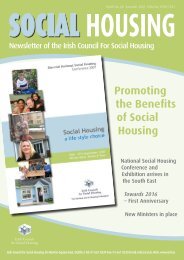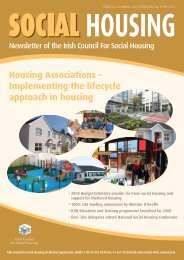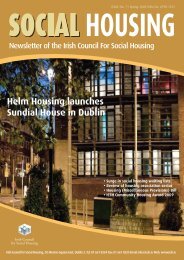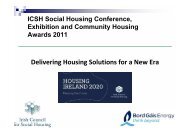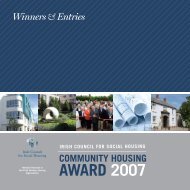National Housing Strategy for People with a Disability 2011 - 2016
National Housing Strategy for People with a Disability 2011 - 2016
National Housing Strategy for People with a Disability 2011 - 2016
You also want an ePaper? Increase the reach of your titles
YUMPU automatically turns print PDFs into web optimized ePapers that Google loves.
Database (NIDD) and the <strong>National</strong> Physical and Sensory <strong>Disability</strong> Database (NPSDD), whichare managed by the Health Research Board (HRB) on behalf of the Department of Health,also provide in<strong>for</strong>mation on the residential circumstances of people <strong>with</strong> disabilities at locallevel. The NIDD, which is a planning tool, contains in<strong>for</strong>mation on 90% – 95% of people<strong>with</strong> intellectual disabilities in services, including detailed in<strong>for</strong>mation on their livingarrangements, but it is accepted that there is under-representation of young children andpeople <strong>with</strong> mild intellectual disabilities. The NPSDD database captures data in respect ofindividuals <strong>with</strong> physical and sensory disabilities who are availing of or require a specialisedhealth social service. It does not provide a definitive number of people <strong>with</strong> physical andsensory disabilities. Furthermore people aged over 66 years of age are not included in thisdatabase. It is also important to note that the databases do not collect in<strong>for</strong>mation inrespect of people <strong>with</strong> a mental health disability.6.19 In<strong>for</strong>mation from the databases can be sorted by disability, age gender, livingcircumstances, county of residence, HSE region of residence and Local Health Office area.In addition, the HRB is currently sorting in<strong>for</strong>mation by electoral district. The utilisation ofHRB data will assist in providing a more comprehensive picture of housing need than thatwhich is available at present.6.20 <strong>Housing</strong> authorities can request in<strong>for</strong>mation from the HRB through following theprocedures outlined on the HRB website www.hrb.ie. It should be noted that names andaddresses of individuals registered on the databases are not held by the HRB. Data will besupplied by the HRB provided that the request complies <strong>with</strong> the criteria set down by theNIDD and NSPDD Committees and does not conflict <strong>with</strong> obligations of confidentiality underthe Data Protection Act 1988 and the Data Protection (Amendment) Act 2003.6.21 Effectively determining the housing needs of people <strong>with</strong> disabilities requires thecollaboration and engagement of key stakeholders in a coordinated and integrated manner.While there are many examples of good collaboration and interaction at local level, a realneed exists <strong>for</strong> a more strategic and solution focused approach. On a broader level, thedevelopment of policy in relation to the housing of people <strong>with</strong> a disability, requires housingauthorities, and other agencies involved in the provision of care and support, to worktogether to plan <strong>for</strong>, deliver and monitor agreed policy objectives. This is essential in thecontext of proposals in respect of the transitioning of people <strong>with</strong> mental health andintellectual disabilities to community based living.6.22 The development of a specific structure, the <strong>Housing</strong> and <strong>Disability</strong> SteeringGroups 36 , to bring together critical stakeholders <strong>with</strong> a shared focus, would serve as a36See Chapter 768



